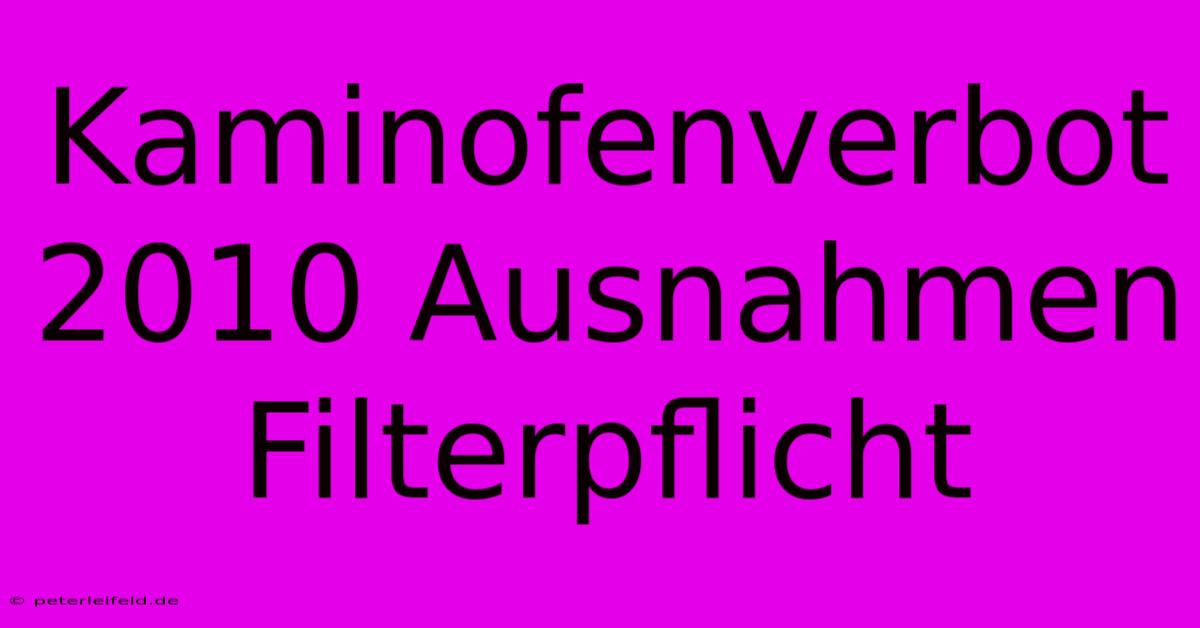Kaminofenverbot 2010 Ausnahmen Filterpflicht

Discover more detailed and exciting information on our website. Click the link below to start your adventure: Visit Best Website Kaminofenverbot 2010 Ausnahmen Filterpflicht. Don't miss out!
Table of Contents
Kaminofenverbot 2010: Ausnahmen und die Filterpflicht – Ein Erfahrungsbericht
Hey Leute! Let's talk about something that really got my goat back in 2010: the Kaminofenverbot and all the confusing rules around it. I mean, who knew buying a cozy wood-burning stove could be such a bureaucratic nightmare?
Back then, I was all set to install a beautiful, new Kaminofen in my little cottage. I pictured myself, sipping hot chocolate, watching the flames dance. Romantic, right? Wrong! Turns out, my idyllic vision crashed and burned faster than a poorly-maintained fireplace. I hadn't done my research properly, and boy, did I pay the price. I completely overlooked the Kaminofenverbot regulations that were coming into effect.
Die Schock-Diagnose: Mein Kaminofen-Albtraum
Imagine my surprise when, after I’d already bought the thing, I discovered that my dream Kaminofen didn’t meet the new emission standards. Apparently, there was this whole new thing about Filterpflicht – a mandatory filter system needed to reduce emissions. My beautiful, shiny new stove was suddenly a huge, expensive mistake. It felt like a punch to the gut. Seriously, I wanted to scream! Talk about buyer's remorse.
Ausnahmen vom Kaminofenverbot: Die Feinheiten des Gesetzes
So, what did I learn from this whole ordeal? A LOT. First of all, don't assume anything. Before you even think about buying a Kaminofen, thoroughly investigate the applicable regulations in your area. The Kaminofenverbot wasn't a blanket ban, thankfully. There were Ausnahmen.
The laws varied from region to region, and there were exemptions for older stoves and specific types of wood-burning appliances. Things like the Baujahr of the stove, its emissions rating (measured in g/kWh) and its type (e.g., a traditional Ofen versus a modern, cleaner-burning model) all mattered.
Die Filterpflicht: Ein Muss oder eine Möglichkeit?
The Filterpflicht was a big part of the equation. Many stoves needed to be retrofitted with particulate filters to meet the new standards. That meant extra costs – and sometimes, it wasn't even possible to retrofit an older stove. This is where getting expert advice was crucial. I didn't, and I regret it deeply.
Was tun? Mein Rat an euch!
If you're considering a Kaminofen, here’s my advice, learned the hard way:
- Check your local regulations: This isn't a one-size-fits-all situation. The rules for Kaminöfen can vary significantly. Your Gemeinde or Kreisverwaltung is your best resource.
- Talk to an expert: Don't rely solely on online information. Consult a Schornsteinfeger or a specialist in Kaminöfen. They can assess your situation and advise you on the best options.
- Understand emission standards: Familiarize yourself with the relevant emission limits for your area. Look for stoves with low emission ratings.
- Factor in the cost of filters: If a filter is required, add this cost to your budget. It can significantly increase the overall expense.
- Consider alternatives: If the regulations make a wood-burning stove impractical or too expensive, explore other heating options.
Looking back, the whole experience was incredibly frustrating. But, hey, at least I learned a valuable lesson (albeit an expensive one!). I now have a perfectly compliant Kaminofen, thanks to following the above steps and seeking professional help. So hopefully, my mistakes will save you from a similar headache. Avoid the stress and do your homework! It's way better than dealing with the aftermath of a bad decision. Trust me on this one.

Thank you for visiting our website wich cover about Kaminofenverbot 2010 Ausnahmen Filterpflicht. We hope the information provided has been useful to you. Feel free to contact us if you have any questions or need further assistance. See you next time and dont miss to bookmark.
Featured Posts
-
Zuerich Aktienmarkt Mittwoch Im Minus
Nov 22, 2024
-
Guenther Jauch Kontakt Nach Der Show
Nov 22, 2024
-
Nations League Auslosung Gruppe Deutschland
Nov 22, 2024
-
Aktienmarkt Altria Aktie Ohne Trend
Nov 22, 2024
-
Ciuca Entfernt Sich Von Johannis
Nov 22, 2024
